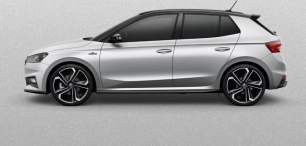Unusually for a manual car, the i20 N features a launch control system (with an adjustable rpm setting), which we found fiddly to get working, but with or without it, Hyundai claims a snappy 0-100km/h time of 6.7sec.
And it’s such a pleasure to steer a car with a slick-shifting manual gearbox. The six-speed unit features a rev-matching function accessed via the press of a racy red button on the steering wheel.
Buf for those who prefer an old-school, double-shuffle, heal-and-toe tap dance across the pedals, the relationship between the brake and accelerator is perfect.
And if you’re keen on Walter Rohrl-style left-foot braking, to help steady the car or steer it in fast cornering, the ESC is switchable through to Sport mode or completely off, allowing fuss-free simultaneous brake and throttle application.
There’s even a shift-timing indicator near the top of the instrument cluster, with colour bars closing in on each other as the tacho needle pushes towards the rev limiter. Fun.
Engine and exhaust noise is a combination of a raspy induction note and adjustable crackle and pop out the back, courtesy of a mechanical flap in the exhaust system, adjustable through three settings in N mode.
Traditionalists may not be thrilled by the addition of in-cabin synthetic enhancement of all of the above, but the net effect is thoroughly enjoyable.
It’s worth remembering in this context N stands for Namyang, Hyundai’s sprawling proving ground south of Seoul where the car was developed, and the Nürburgring where this go-fast i20 was fine-tuned.
The body has been specifically reinforced at 12 key points, along with additional welds, and “bolt-in underbody structures” to make the i20 N stiffer and more responsive.
The strut front, coupled (dual) torsion beam rear suspension has also been set up with increased (neg) camber and a revised anti-roll bar at the front, as well as specific springs, shocks and bushings.
A compact, mechanical LSD is added to the mix, and grippy 215/40 x 18 Pirelli P-Zero rubber was produced specifically for the car and is stamped ‘HN’ for Hyundai N. Impressive.
The end result is outstanding. Low-speed ride is firm, with suburban bumps and lumps making their presence felt, but that’s what you’re signing on for in a hot hatch at this price point.
This car feels balanced and well buttoned down. Power delivery is agreeably linear and at a fraction over 1.2 tonnes the i20 N is light, responsive and nimble. Mid-range urge is strong.
Steering feel is good, with assistance from a column-mounted motor taking nothing away from an intimate connection with the front tyres.
The sports front seats proved grippy and comfortable over long stints behind the wheel, and playing with the multiple N drive modes tweaking the engine, ESC, exhaust, and steering just adds to the involvement. There are twin N switches on the wheel for quick access to custom set-ups.
And that Torsen LSD is brilliant. I tried my best to provoke a spinning inside front wheel on the exit of tight corners, but the i20 N just puts its power down without so much as a chirp, as it rockets towards the next bend.
The brakes are 320mm vented at the front and 262mm solid at the rear. Calipers are single piston, but they’ve been beefed up and fitted with high-friction pads. The master cylinder is bigger than the standard i20 and the front rotors are cooled by lower control arm mounted air guides blowing through vented knuckles.
The launch i20 N fleet of around half a dozen cars copped an hours long hot lap pounding at Wakefield Park Raceway, near Goulburn NSW without drama. They’re well up to the task.
One niggle is a large turning circle. The data sheet says 10.5m but it feels like the car is carving a wide arc in U-turns or three-point turns.
A 2580mm wheelbase between the bumpers of a 4075mm car is substantial, and the steering’s relatively low gearing (2.2 turns lock-to-lock) no doubt has a lot to do with it. The price you pay for quick turn-in.













.png)



























